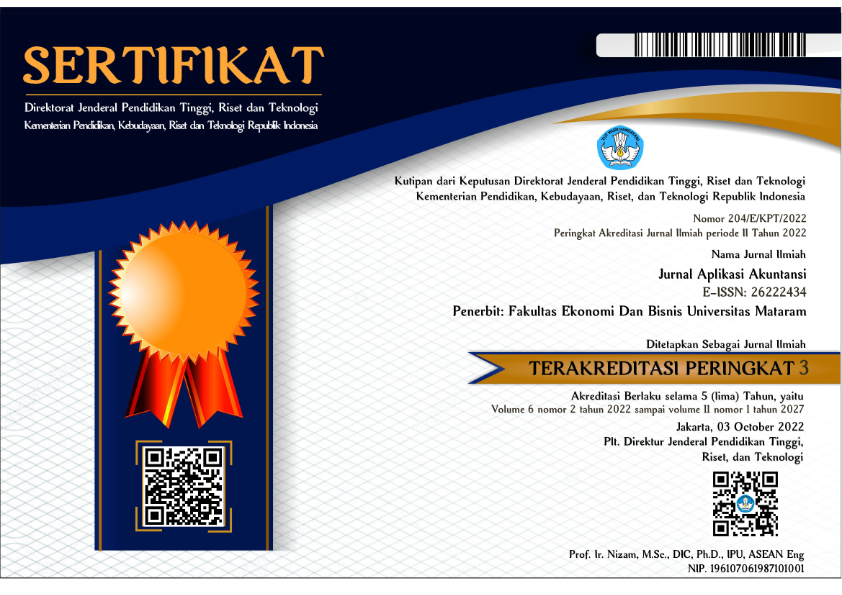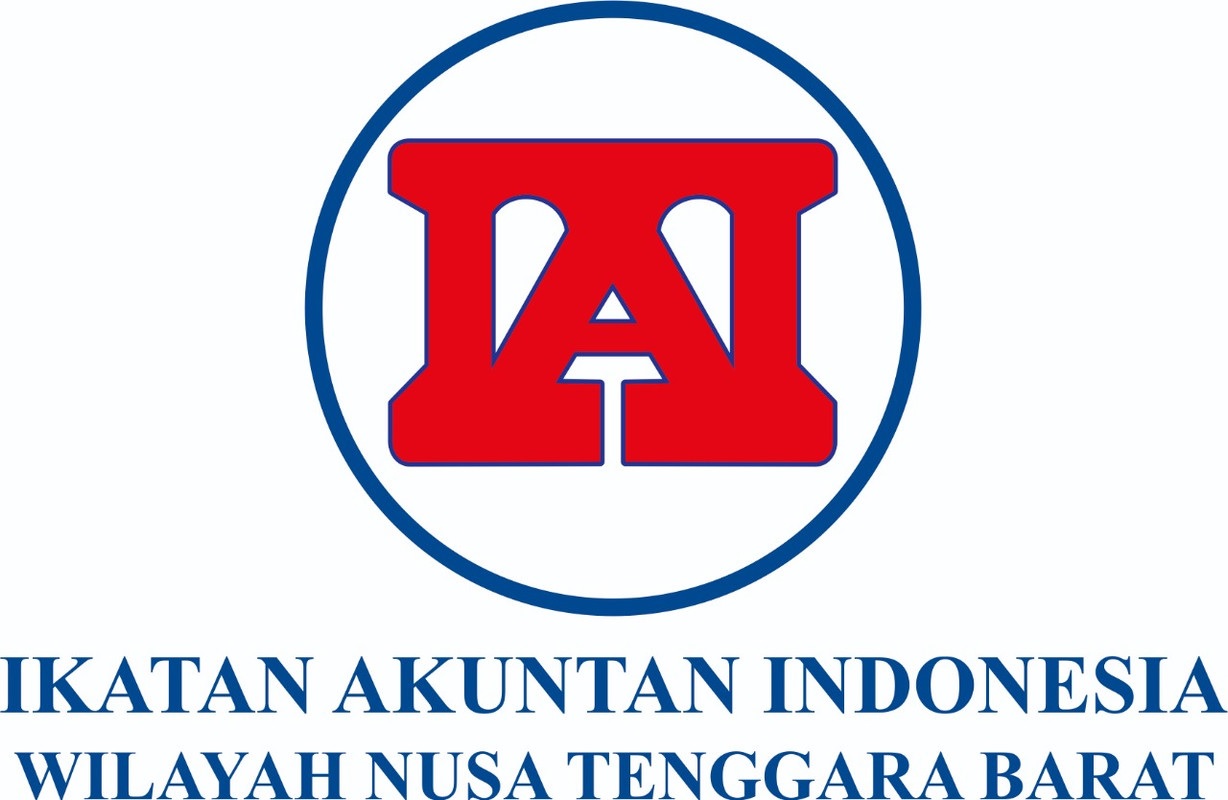APAKAH GCG MEMODERASI PENGARUH EARNING DAN CAPITAL TERHADAP KINERJA KEUANGAN BANK UMUM?
DOI:
https://doi.org/10.29303/jaa.v7i2.188Keywords:
ROA, NIM, CAR, GCGAbstract
Kegiatan operasi/bisnis pada bank umum berfokus pada pengoptimalan pendapatan (earnings) dan pengelolaan penggunaan modal (capital). Oleh karena itu, penerapan GCG pada bank umum menitikberatkan pada pengoptimalan pendapatan (earnings) dan pengelolaan penggunaan modal (capital). Penelitian ini menggunakan metode purposive sampling yang menghasilkan sampel sesuai dengan kriteria yaitu sebesar 18 perusahaan perbankan. Penelitian ini menggunakan metode SEM-PLS dengan alat statistik WarpPLS yang menguji hipotesis menggunakan path analysis. Hasil uji hipotesis menunjukkan bahwa earnings berpengaruh positif terhadap kinerja keuangan didukung, capital berpengaruh positif terhadap kinerja keuangan tidak didukung, GCG memoderasi pengaruh earnings terhadap kinerja keuangan tidak didukung, dan GCG memoderasi pengaruh capital terhadap kinerja keuangan didukung.
References
Andrews, I., Gentzkow, M., & Shapiro, J. M. (2020). On the Informativeness of Descriptive Statistics for Structural Estimates. Econometrica, 88 (6). https://doi.org/10.3982/ecta16768
Angori, G., Aristei, D., & Gallo, M. (2019). Determinants of banks’ net interest margin: Evidence from the Euro Area during the crisis and post-crisis period. Sustainability (Switzerland), 11 (14). https://doi.org/10.3390/su11143785
Bikker, J. A., & Vervliet, T. M. (2018). Bank profitability and risk-taking under low interest rates. International Journal of Finance and Economics, 23(1). https://doi.org/10.1002/ijfe.1595
Blum, J. (1999). Do capital adequacy requirements reduce risks in banking? Journal of Banking and Finance, 23 (5). https://doi.org/10.1016/S0378-4266(98)00113-7
Busch, R., & Memmel, C. (2017). Banks’ net interest margin and the level of interest rates. Credit and Capital Markets, 50 (3). https://doi.org/10.3790/ccm.50.3.363
Chen, Y. K., Shen, C. H., Kao, L., & Yeh, C. Y. (2018). Bank Liquidity Risk and Performance. Review of Pacific Basin Financial Markets and Policies, 21(1). https://doi.org/10.1142/S0219091518500078
Cruz-García, P., & Fernández de Guevara, J. (2020). Determinants of net interest margin: the effect of capital requirements and deposit insurance scheme. European Journal of Finance, 26 (11). https://doi.org/10.1080/1351847X.2019.1700149
Curcio, D., & Hasan, I. (2015). Earnings and capital management and signaling: the use of loan-loss provisions by European banks. European Journal of Finance, 21 (1). https://doi.org/10.1080/1351847X.2012.762408
Elnahass, M., Izzeldin, M., & Steele, G. (2018). Capital and Earnings Management: Evidence from Alternative Banking Business Models. International Journal of Accounting, 53 (1). https://doi.org/10.1016/j.intacc.2018.02.002
Farooq, M., Khan, S., Atique Siddiqui, A., Tariq Khan, M., & Kamran Khan, M. (2021). Determinants Of Profitability: A Case Of Commercial Banks In Pakistan. Humanities & Social Sciences Reviews, 9 (2). https://doi.org/10.18510/hssr.2021.921
Ha, J. (2021). Bank accounting conservatism and bank loan quality. Journal of Business Finance and Accounting, 48 (3–4). https://doi.org/10.1111/jbfa.12484
Ha, V. D. (2020). Does bank capital affect profitability and risk in Vietnam? Accounting, 6 (3). https://doi.org/10.5267/j.ac.2020.2.008
Hantono. (2017). Effect of Capital Adequacy Ratio (CAR), Loan to Deposit Ratio (LDR) and Non Performing Loan (NPL) to Return on Assets (ROA) Listed in Banking in Indonesia Stock Exchange. International Journal of Education and Research, 5(1).
Hubert, P., & Labondance, F. (2021). The signaling effects of central bank tone. European Economic Review, 133. https://doi.org/10.1016/j.euroecorev.2021.103684
Iramani, R. R., Mongid, A., & Muazaroh, M. (2018). Positive contribution of the good corporate governance rating to stability and performance: evidence from Indonesia. Problems and Perspectives in Management, 16 (2). https://doi.org/10.21511/ppm.16(2).2018.01
Isnurhadi, I., Adam, M., Sulastri, S., Andriana, I., & Muizzuddin, M. (2021). Bank Capital, Efficiency and Risk: Evidence from Islamic Banks. Journal of Asian Finance, Economics and Business, 8 (1). https://doi.org/10.13106/jafeb.2021.vol8.no1.841
Khan, U., & Lo, A. K. (2019). Bank lending standards and borrower accounting conservatism. Management Science, 65 (11). https://doi.org/10.1287/mnsc.2018.3094
Kozak, S. (2021). The impact of covid‐19 on bank equity and performance: the case of central eastern south european countries. Sustainability (Switzerland), 13(19). https://doi.org/10.3390/su131911036
Le, T. D. Q., Nguyen, L. T., & Tran, S. H. (2021). Loan loss provisions, earnings management, capital management, and signalling: The case of Vietnamese banks. Afro-Asian Journal of Finance and Accounting, 11 (5). https://doi.org/10.1504/AAJFA.2021.119478
Napitupulu, S., Primiana, I., Nidar, S. R., Effendy, N., & Puspitasari, D. M. (2020). The effect of management capabilities in implementing good corporate governance: A study from indonesia banking sector. Journal of Asian Finance, Economics and Business, 7 (1). https://doi.org/10.13106/jafeb.2020.vol7.no1.159
Nguyen, A. H., Nguyen, H. T., & Pham, H. T. (2020). Applying the CAMEL model to assess performance of commercial banks: Empirical evidence from Vietnam. Banks and Bank Systems, 15 (2). https://doi.org/10.21511/bbs.15(2).2020.16
Otoritas Jasa Keuangan. (2016). Peraturan Otoritas Jasa Keuangan Nomor 55 /POJK.03/2016 Tentang Penerapan Tata Kelola Bagi Bank Umum. POJK Nomor 55/POJK.03/2016, 1–31.
Otoritas Jasa Keuangan. (2021). Peraturan Otoritas Jasa Keuangan Republik Indonesia Nomor 12/POJK.03/2021 tentang Bank Umum. www.ojk.go.id, 1–113.
Permatasari, I. (2020). Does corporate governance affect bank risk management? Case study of Indonesian banks. International Trade, Politics and Development, 4 (2), 127–139. https://doi.org/10.1108/itpd-05-2020-0063
Pronosokodewo, B. G., Adhivinna, V. V, & Adyaksana, R. I., (2022). Kontribusi GCG Dalam Meminimalisasi Risiko Profil Dan Meningkatkan Kinerja Keuangan Bank Umum. PRIVE: Jurnal Riset Akuntansi dan Keuangan, 5 (9), 181–191. https://doi.org/10.36815/prive.v5i2.2164
Puspitasari, E., Sudiyatno, B., Hartoto, W. E., & Widati, L. W. (2021). Net Interest Margin and Return on Assets: A Case Study in Indonesia. Journal of Asian Finance, Economics and Business, 8 (4). https://doi.org/10.13106/jafeb.2021.vol8.no4.0727
Rissi, D.M., & Herman, L.A., (2020). Hubungan Penerapan Good Corporate Governance (GCG) dengan Risiko Financial Perbankan. Akuntansi Dan Manajemen, 15 (2). https://doi.org/10.30630/jam.v15i2.12
Ross, S. A. (1977). Determination Of Financial Structure: The Incentive-Signalling Approach. Bell J Econ, 8(1). https://doi.org/10.2307/3003485
Saputra, A. A., Najmudin, & Shaferi, I. (2020). the Effect of Credit Risk, Liquidity Risk and Capital Adequacy on Bank Stability. Sustainable Competitive Advantage (SCA), 10 (1).
Shmueli, G., Sarstedt, M., Hair, J. F., Cheah, J. H., Ting, H., Vaithilingam, S., & Ringle, C. M. (2019). Predictive model assessment in PLS-SEM: guidelines for using PLSpredict. European Journal of Marketing, 53 (11). https://doi.org/10.1108/EJM-02-2019-0189
Stefanovic, N., Barjaktarovic, L., & Bataev, A. (2021). Digitainability and financial performance: evidence from the serbian banking sector. Sustainability (Switzerland), 13 (23). https://doi.org/10.3390/su132313461
Downloads
Published
How to Cite
Issue
Section
License
Copyright (c) 2023 Baniady Gennody Pronosokodewo, Vidya Vitta Adhivinna, Lulu Amalia Nusron

This work is licensed under a Creative Commons Attribution-NonCommercial-ShareAlike 4.0 International License.









